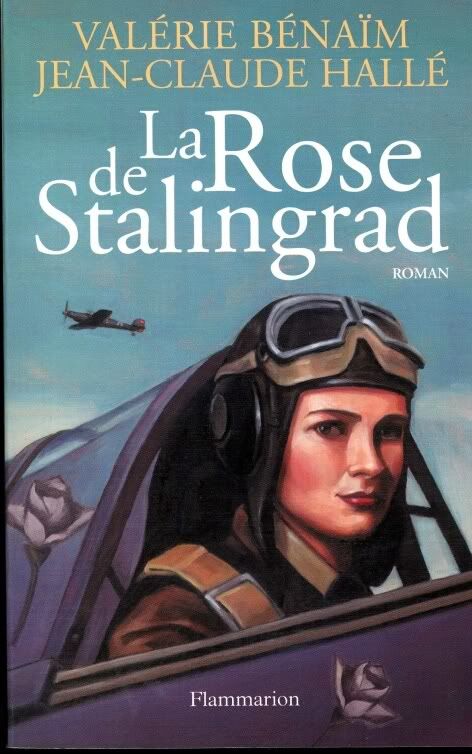Without reservation or hesitation, my all time favorite WWII Ace Fighter Pilot is...
Senior Lieutenant Lilya Vladimirovna Litvyak, known as
The White Rose of Stalingrad.
So named by the Luftwaffe pilots she flew against in combat during WWII.

Lilya's rides were the La-5, Yak-1, and Yak-1b (and people wonder why I have often been seen flying in an La-5 or La-7, and sometimes a Yak). Her first three kills were a Bf109 and two Ju-88s while flying an La-5 during the last half of September 1942.
She is credited with shooting down 12 German planes. The all-male Luftwaffe pilots she flew against were so outraged by her they planned and staged a gang-bang to end her life. They could not handle being shot down by a woman, and a Jewish woman at that.
It required all eight of the German men in Bf109s working together to finally bring her down. They knew it was her by the white lily painted on her Yak-1b; they planned the coordinated attack on her ahead of time; then specifically set out on a misson to kill her.
She was buried where she came to ground ...her grave was placed beneath the wing of her crashed Yak-1b fighter.
Lt. Litvyak had completed 168 missions, and had 3 shared victories in addition to her personal twelve. She was 22 years old when she died.
Had she been an American pilot with her service record, she would have received, if nothing else, three Purple Hearts.
She recieved the
Order of the Red Banner in 1943 and, long after her death, she received the equivilant of the US Congressional Medal of Honor... by virtue of being posthumously conferred with the title of
Hero of the Soviet Union by Premier Mikhail Gorbachov on May 5, 1990.
A more detailed accounting of Lilya's story...
Lilya was born in Moscow in August 18, 1921. Lilya was her nickname, as her actual name was Lidiya. She was regarded by all as a "strikingly beautiful woman", which helped earn her public appreciation and, added to her success as a fighter pilot, served the propaganda ministry well.
She began her service in the all-woman 586th IAP, where she flew mostly defense missions from January to August 1942. In August she was posted to "male" squadrons because of her merits. The first was the 286th Fighter Division (IAD), then to the 437 IAP, which had recently been equipped with the new Lavochkin La-5. With this unit she got her first 2 air victories in September 13, 1943. She was sent as an attachment to the female flight of the 287 IAD, and served briefly in the 9th Guards IAP.
In the end of January, 1943, she was transferred to the 296th along with 2 other skilled women fighter pilots. On February 17, 1943, she was awarded the Order of the Red Banner. Two days later she was promoted to Junior Lieutenant and soon after to Senior Lieutenant.
On each side of her YaK-1's cockpit she painted a white lily, often confused for a rose—hence the nickname. She was so fond of flowers, that she often picked wildflowers and carried them aloft on her missions. According to her mechanic, Inna Pasportnikova, she had a postcard with yellow roses in her instrument panel. The white rose on the fuselage became famous among the Germans, who knew better than to try to dogfight the familiar YaK-1, and usually tried to make good their escape before Litvyak got too close.
Litvyak was injured 3 times during her combat tour. All three injuries occured during the Spring and Summer of 1943, a period of intense combat activity. The first time was on March 15, the same day that she shot down a Junkers Ju-88 bomber, but got hit by their escorting Me-109s (she continued to fly and bagged another Ju-88!). She managed to land at her base, and passed out and she remained in a hospital until May.
When she came back, the 296th IAP had been renamed the 73 Guards IAP for their exploits in battle. She was wounded again in combat in July 16 and 18 (the death-date of her comrade Katya Budanova). Both times she landed in German-ocuppied territory, but got back to base on foot the first time, and was rescued by another fighter pilot who landed after her the second.
She was repeatedly successful in flying missions, although was finally killed in action over Orel, while escorting a unit of Shturmoviks returning from an attack in August 1, 1943. Because of her notoriety amongst the Germans, eight Messerschmitt Me-109's concentrated solely on Lilya's YaK-1, and it took all eight of them to finally shoot down the "White Rose of Stalingrad". Her body and aircraft were not found during the war, but a marble monument, with 12 gold stars—one for each enemy plane that she had shot down—was erected in her memory in Krasy Luch, in the Donetsk region. Litvyak had completed 168 missions, and had 3 shared victories in addition to her personal twelve. She was 22 years old when she died.
Note: Some sources claim that she died in September the 1st, and not August. As with most details from the Great Patriotic War, 46 years of censorship has made it hard to be sure about anything.
Her remains were found at last in 1979, buried under her fallen YaK-1's wing, near the village of Dmitriyevka. Ten years later her body was recovered for an official burial; and in May 5, 1990 she was posthumously conferred the title of Hero of the Soviet Union by then Premier Mikhail Gorbachov.
To view some of her pictures and a list of her kills, see...
The Rose of StalingradTIGERESS